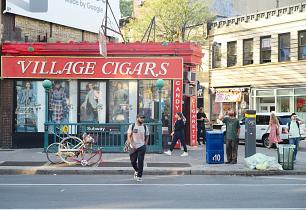What Happened to the West Village?
I arrived in New York in 2013 and moved into a rent-stabilized apartment on a prime stretch of Bank Street in the West Village. My circumstances suggested time travel: the cracking plaster on my living room walls and my monthly rent had barely been altered since the early Eighties. From my rear window, I gazed at the privacy-glass panes enclosing the four-story townhouse next door, formerly owned by A-Rod. I dropped downstairs to Little Marc Jacobs—the brand’s now-closed children’s clothing outpost, then in my building’s ground-floor—to pick up babysitting jobs with the store’s customers, later finding myself in the living rooms of their nearby townhouses, worth millions.
The apartment was never mine; my aunt’s friend had lived there for decades and wanted someone to watch over her place while she cared for her elderly parents in another state. Our landlord took a hands-off view of the arrangement, and, without qualms, I seized the nepotistic advantage that has for decades granted a shrinking and somewhat arbitrary class of New Yorkers access to affordable housing from bygone eras, even as the rest of the Village became increasingly expensive.




